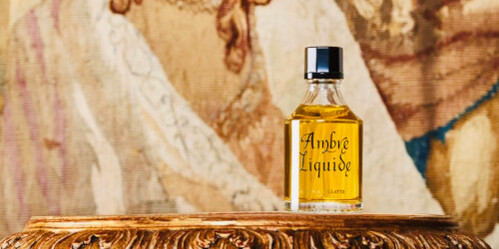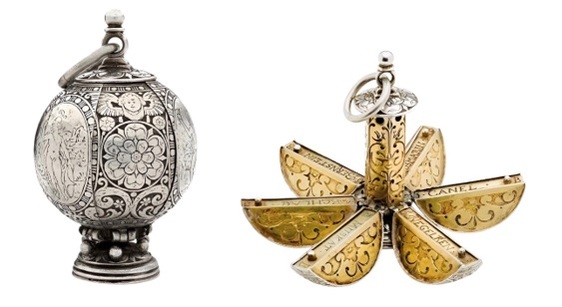
Drawn straight from the fantastical Middle Ages and the legendary pomander – that perfume-jewel used to ensure good health for body and soul – Ambre Liquide, like a precious talisman, exhales a marvelous amber, vanilla and slightly sweet scent with mystical, comforting powers.
Reinterpreted today by Dominique Ropion from an incredible recipe dating from 1348, rich in fragrant ingredients to ward off the Black Death and the forces of evil, its intensely fragrant formula immediately transports us to another world. — Astier de Villatte
For many of us, a ‘pomander’ is a fresh orange studded with cloves (the dried unopened flower buds of the Syzygium aromaticum tree). To express my own opinion on pomanders, I’ll take the liberty of tweaking Greta Garbo’s first spoken line onscreen in the 1930 film Anna Christie — “Gimme a pomander, lots of cloves on the sides, and don’t be stingy, baby!”1 In other words, if you’re going to go easy on the cloves, don’t bother making a pomander!
From the late 14th century thru the 17th century, a pomander (pomme d’ambre) could be a clove-studded orange, a spice-filled orange or cloth bag, an apple-shaped item formed from ground and heated resins mixed in rose water and coated in musks and spices, or a piece of jewelry that housed fragrant perfume materials. (The word ‘pomander’ can be used for both the fragrant contents and the object that houses them.) Fancy metal pomanders for the wealthy usually dangled from the neck or waist on long chains. Small pomanders were made in ring size for quick, inconspicuous sniffs – in case you were, say, lunching with a particularly odiferous personage.

Many jewelry pomanders had compartments (most often arranged in the round in fillable segments – imagine orange segments). The fragrant materials used usually included musks – ambergris (which led to the name pomme d’ambre – amber apple), deer musk, civet. Other popular pomander ‘fillings’ were angelica, benzoin, camphor, cinnamon, cistus, all-important cloves, labdanum, mace, mint, myrrh, nutmeg, powdered iris root, rose and rosemary.
The fragrant pomander, whether simple or deluxe, was supposed to protect its wearer from “foul air” that could cause bubonic plague. A secondary attribute of pomanders was they shielded noses from stinking environments (almost all indoor spaces) — rooms filled with the aromas of chamber pots and their contents, spoiled foods, damp plaster, sweat-soaked clothes and wigs, rotting teeth and unwashed bodies (hardly anyone felt the need to bathe completely more than once a year).
Some famous owners of pomanders? Mary Queen of Scots, the Duke of Buckingham and the gentleman below, writer John Evelyn (1620-1706), who eschewed jewelry pomanders and chose a simple orange instead (among his many hobbies was gardening).

Astier de Villatte Ambre Liquide is an interesting perfume — it changes character often! During its development, Ambre Liquide provides many moods: festive, medicinal, liturgical (somber) and cozy. Wearing the fragrance during the course of a week, I was never sure which mood Ambre Liquid would present on a given day. There’s also a marked difference between the perfume on fabric and on skin. If you want to skip the somber phase, make sure some of the perfume is on your shirt, sweater or scarf — then you’ll always smell some lively spice.
Ambre Liquide’s top notes smell of peppery citrus peels — “winter citrus” (not cologne-like or summery); I imagined thick, oily peels dancing in a hot, bubbling sugar bath. As the fruity top notes subside, I begin to detect saffron (and perhaps cistus) — leathery, silky-smooth — combining with a rich rosewater aroma.
Floating throughout Ambre Liquide’s mid-stage of development are the scents of cloves and cinnamon (the cinnamon has an unsweetened, non-dessert vibe). My favorite stage of Ambre Liquide’s development comes about 30 min. after a lavish application of the perfume when a “flower-in-a-cold greenhouse” aroma emerges — imagine smelling the perfumes of sweet box or Edgeworthia (or any heavily-scented winter-flowering plant) wafting on icy air.
As flower and spices subside, I begin to detect the fragrance of burning incense mixing with vanillic benzoin. At the very end of Ambre Liquide’s development (and lasting for hours), I smell one of two finales: a ‘solemn’ aroma that I visualize as incense soot covering a massive cistus ladanifer plant in full resiny, sticky ripeness or a comfy amber scent (darker in character than classic ambers).
Tip: I noticed a light spray of the perfume made the Damask rose note come to the fore in mid-development while a heavier application produced a musky incense-labdanum aroma (with hardly a hint of rose noticeable).
Ambre Liquide has good lasting power and medium sillage; I bought a 10 ml bottle and am enjoying it very much in the cold days of late winter.
Even after pomanders ceased to be used to prevent the plague, their fragrant ingredients found their way into vinegars, sugar cane syrups, perfumes and sachets. One of my all-time favorite pomander-type perfumes was Diptyque L’Eau — requiescat in pace.
Ambre Liquide lists notes of spices, amber, cistus absolute, Damask rose, myrrh, styrax resin and frankincense.
Astier de Villatte Ambre Liquide is available in 10 ($58), 30 and 100 ($295) ml Eau de Parfum.
1. “Gimme a whisky, ginger ale on the side, and don’t be stingy, baby!”
Note: bottom image is detail from John Evelyn (1620–1706) by Adriaen Hanneman, the Shakespeare Birthplace Trust, some rights reserved.